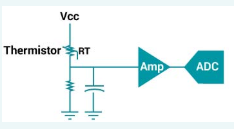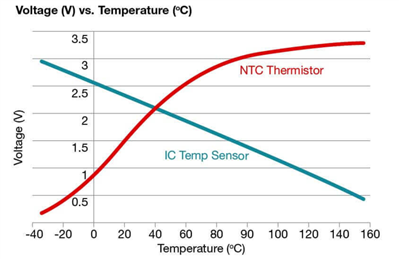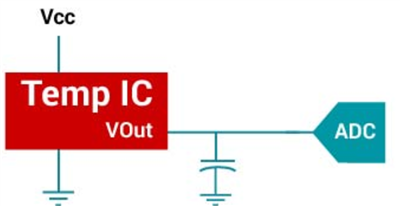SSZT690 june 2018 LMT87-Q1 , TMP102-Q1 , TMP235-Q1
Automotive manufacturers all over the world are focused on vehicle electrification and providing vehicle owners with more advanced driver assistance systems (ADAS) features. As vehicle electrification technology improves, we will see cars charge more quickly and have a more extended range on a single charge.
ADAS technologies will evolve to the point where we will achieve near-autonomous if not completely autonomous driving in the future. However, given the high temperatures reached in automotive powertrains and the extreme temperatures in which vehicles must operate, there is a need for robust thermal-management solutions to ensure that safety-critical applications remain operational. Furthermore, there are electronic control units (ECUs) throughout cars that control the head unit, cluster, heating, ventilation and air conditioning (HVAC), lighting and other things essential to vehicle function. The temperature of these ECUs must be closely monitored so that they can continue to function and properly control overall vehicle performance.
Negative temperature coefficient (NTC) thermistors are among the most common devices used to monitor ECU temperatures. The NTC is a passive resistor, and the resistance of an NTC varies with temperature. More specifically, as the ambient temperature around an NTC increases, the resistance of the NTC decreases. Engineers will place the NTC into a voltage divider, as shown in Figure 1, with the output signal of the voltage divider read into the analog-to-digital converter (ADC) channel of a microcontroller (MCU).
 Figure 1 Thermistor-based Temperature
Monitoring
Figure 1 Thermistor-based Temperature
MonitoringHowever, there are a few NTC characteristics that can make them difficult to use in an automotive environment. As previously mentioned, the resistance of an NTC varies inversely with temperature, but it is a very nonlinear relationship. Figure 2 shows an example of a typical NTC-based voltage divider.
 Figure 2 NTC-based vs. Temperature
Sensor Integrated Circuit (IC) Voltage Response
Figure 2 NTC-based vs. Temperature
Sensor Integrated Circuit (IC) Voltage ResponseWhen you consider the heat generated from a combustion engine and climates that exist in different regions of the world, it becomes clear that a vehicle’s semiconductor components will be exposed to a wide range of temperatures (-40°C to 150°C). Over a wide temperature range, the nonlinear behavior of the NTC will make it difficult to reduce errors as you translate a voltage reading to an actual temperature measurement. The error introduced from an NTC’s nonlinear curve lowers the accuracy of any NTC-based temperature reading. Coping with this nonlinear behavior requires leveraging these two strategies:
- Using a deep lookup table (LUT) to store many values that map the NTC-based voltage divider output to temperature.
- Using a high-order polynomial equation to approximate the nonlinear output of the NTC-based voltage divider.
The LUT approach will increase memory requirements for your system, and the high-order polynomial equation will consume many CPU cycles. However, TI has a broad portfolio of analog output temperature sensors that serve as an easy-to-use alternative to NTCs. As Figure 2 shows, an analog output IC temperature sensor will have a more linear response when compared to NTCs and can easily connect to the ADC of an MCU (see Figure 3).
 Figure 3 Temperature-sensing IC
circuit
Figure 3 Temperature-sensing IC
circuitThe linear response of the analog output temperature sensor IC removes the need for complex polynomial equations and deep LUTs. With analog temperature sensor ICs, the relationship can be stored in a comparatively smaller LUT, reducing both memory and central processing unit (CPU) usage. Analog temperature sensor IC specifications are guaranteed by TI and do not require device-level calibration. Finally, analog temperature sensor ICs often have superior temperature sensitivity at high temperatures compared to NTCs.
For example, TI’s LMT87-Q1 enables you to monitor temperature with an accuracy of ±2.7°C from -40°C to +150°C (Automotive Electronics Council [AEC]-Q100 Grade 0 qualified). To further simplify your thermal management implementation, TI offers digital temperature sensors that will directly communicate temperature over interfaces like I²C and Serial Peripheral Interface (SPI). The TMP102-Q1 will monitor temperature with an accuracy of ±3.0°C from -40°C to +125°C and directly communicate the temperature over I²C to the MCU. This completely removes the need for any sort of LUT or calculation based on a polynomial function.
NTC thermistors are often used to monitor temperature, but their nonlinear temperature response can prove problematic for automotive solutions. TI’s analog and digital temperature sensor solutions enable you to both accurately and easily monitor the temperature of many automotive systems.
Additional Resources:
- Check out TI’s temperature sensor portfolio.
- Explore TI’s automotive solutions portal.
- Learn more about TI’s powertrain solutions.